Introduction
Most lead magnets don’t fail because they’re poorly made. They fail because they don’t offer something people actually need.
When the content feels generic or irrelevant, audiences ignore it and your list growth stalls.
This guide shows you proven lead magnet examples that attract attention, qualify leads, and convert.
Each format here has been tested across real businesses from SaaS startups to service providers, affiliate funnels, and personal brands.
You’ll learn what works, why it works, and how to adapt it for your audience without wasting time on ideas that don’t convert.
If you want clear, practical examples that deliver results, start here.
Key Takeaways
Lead Magnet Examples That Convert
- The right lead magnet can turn cold traffic into qualified leads fast.
- Different formats convert better depending on the platform, audience, and offer.
- This article breaks down proven lead magnet examples by type and purpose not just theory.
- From swipe files and quizzes to calculators and webinars, every example here is built to attract attention and drive results.
- Whether you’re in B2B, eCommerce, coaching, or content these are plug-and-play ideas you can use or adapt today.
Disclaimer: I am an independent Affiliate. The opinions expressed here are my own and are not official statements. If you follow a link and make a purchase, I may earn a commission.
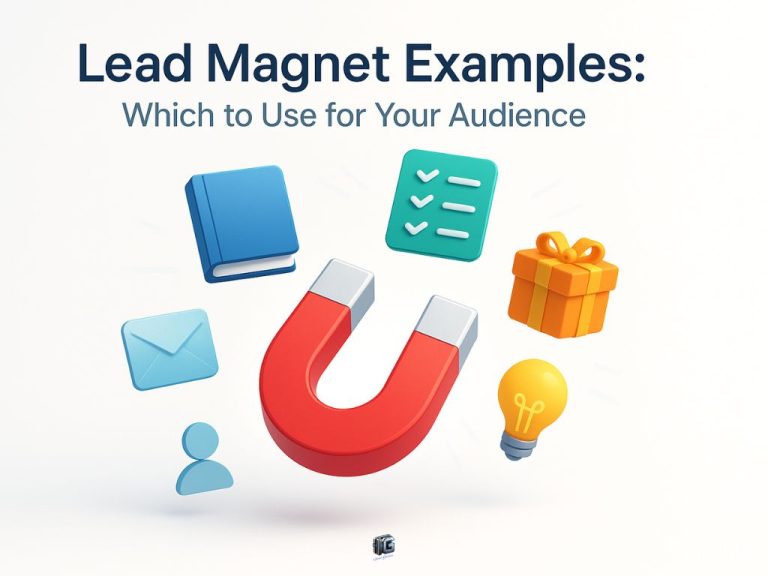
Lead Magnet Examples That Convert
Not all lead magnets are created equal. Some attract leads. Some attract buyers. The best do both.
Below are high-performing lead magnet formats each with real-world examples and notes on why they work. Use them as-is or adapt them to your offer and audience.
For a deeper dive into the fundamentals of lead magnets, read our Lead Magnets guide.
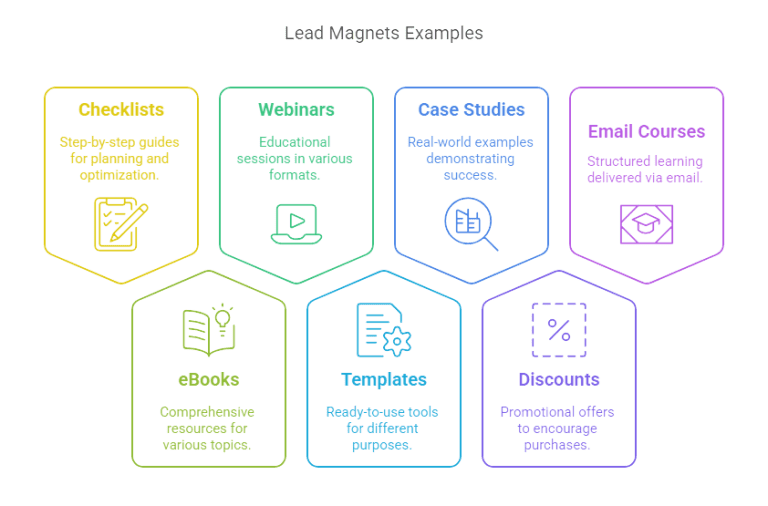
1. Checklists, Swipe Files & Cheat Sheets
These formats offer fast, actionable value perfect for turning casual visitors into subscribers. They’re short, easy to use, and help people achieve a quick win without reading a full guide or course.
When executed well, they can convert even cold traffic because they promise immediate results with minimal effort.
Examples:
- SEO Audit Checklist. A step-by-step PDF for basic site optimizations. Ideal for freelancers, agencies, and SaaS companies targeting business owners who want quick SEO improvements.
- 30 Subject Line Swipe File. A curated list of proven subject lines that increase email open rates. Works for creators, marketers, and solopreneurs building their email lists.
- Product Launch Checklist. A structured list of pre-launch, launch, and post-launch tasks. Useful for course creators, consultants, and DTC brands managing multiple campaigns.
Why It Works:
- Offers immediate, tangible value, no theory, just application.
- Low friction: users can consume and act on it within minutes.
- Builds trust by helping before selling.
- Highly shareable, especially effective on social media, blogs, and cold traffic pages.
Pro Tip: Keep your checklist or swipe file short and specific. “10 steps that fix one problem” outperforms “50 general tips.” Use a clear promise in your headline (e.g., “Fix your SEO in 20 minutes”) to drive sign-ups.
Turn Your Content Into Ready-to-Share Lead Magnets in Minutes.
- Create instantly – Generate complete lead magnets from your videos, posts, or ideas in minutes.
- Smart assistance – AI helps structure and format your content automatically.
- Built-in opt-ins – Every lead magnet comes with its own shareable sign-up page.
- Simple dashboard – Manage and update all your lead magnets in one place.
- Effortless integration – Connect to your email tools for quick delivery and follow-up.
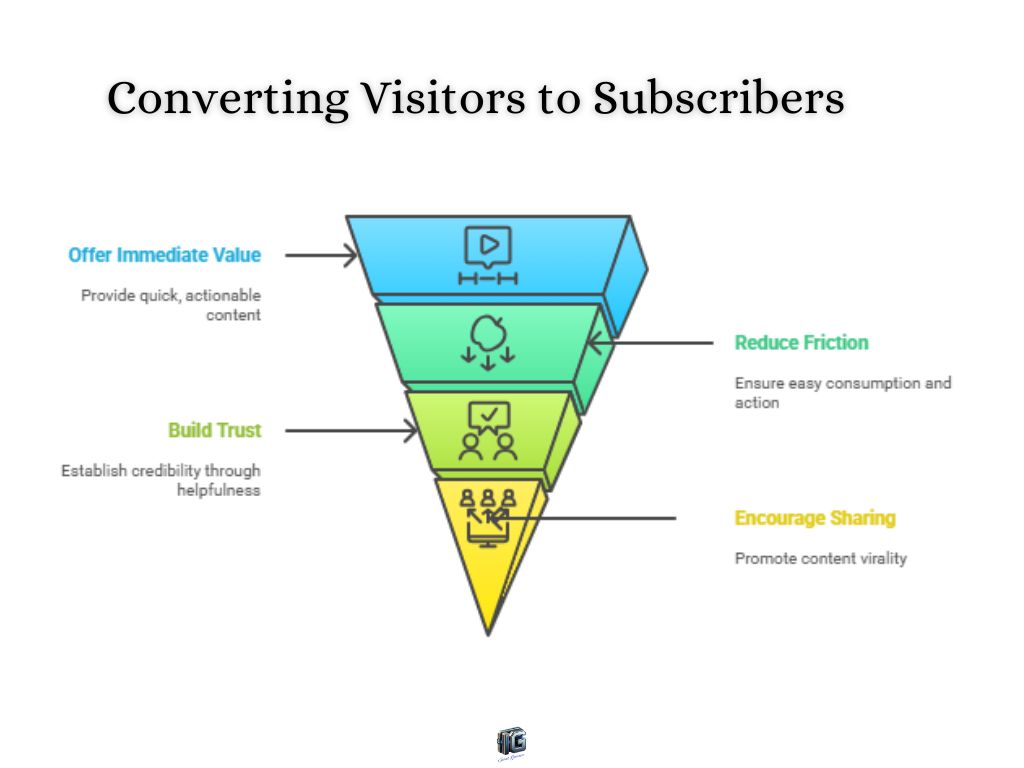
2. Templates & Scripts
Templates eliminate guesswork. They hand people a shortcut, something they can copy, customize, and apply instantly. That’s why they consistently outperform long-form lead magnets, especially when time and clarity matter most.
These work across nearly every niche because they reduce effort and increase confidence. Your audience doesn’t just want information, they want execution.
Examples:
- Client Onboarding Email Template. A ready-to-send sequence that helps freelancers and agencies onboard new clients smoothly. Reinforces professionalism and saves hours of back-and-forth communication.
- Instagram Reel Caption Templates. Prewritten captions built for engagement. Great for ecommerce brands, influencers, and digital product creators looking to maintain consistent posting.
- Sales Call Script. A structured discovery call outline that keeps conversations focused and professional. Perfect for coaches, consultants, or service providers handling high-ticket clients.
Why It Works:
- Removes friction: people don’t need to start from scratch.
- Offers plug-and-play results, they can copy, tweak, and use immediately.
- Feeds directly into your paid offers (coaching, software, or training).
- Easy to showcase visually screenshots, snippets, or short demos perform well in ads or landing pages.
Pro Tip: Make the template feel exclusive, not generic. Use precise headlines (“The 5-Email Client Onboarding Sequence That Saves Hours”) and highlight the result it creates, not just what it is.
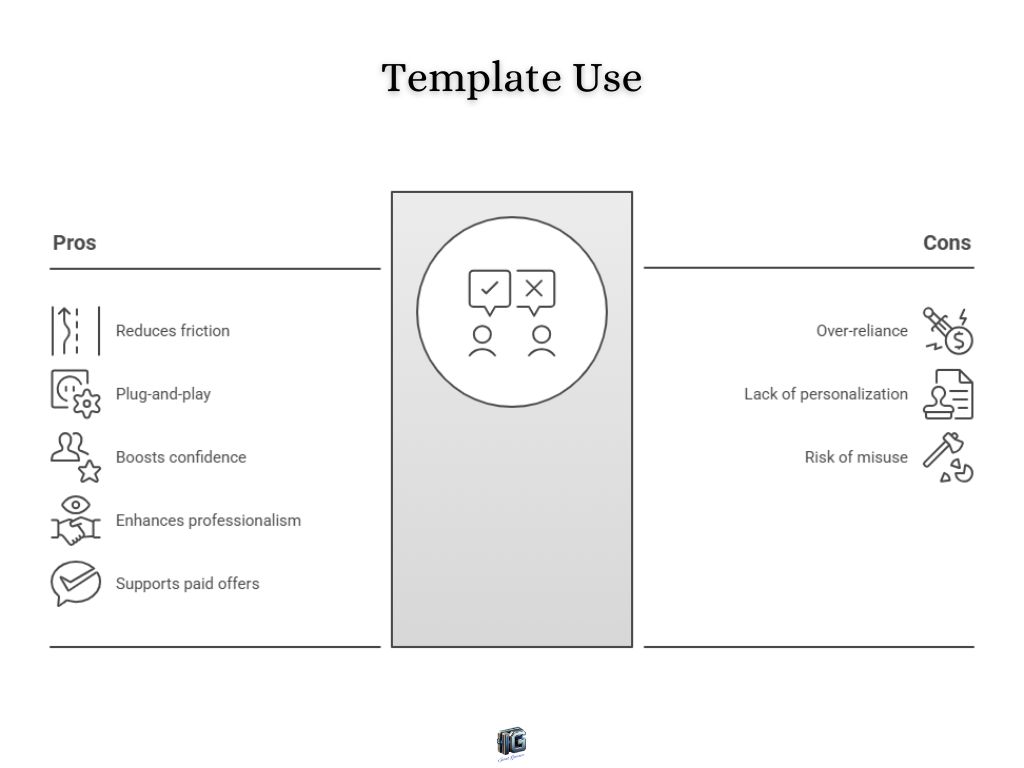
3. Calculators & Interactive Tools
Interactive lead magnets work because they give instant, personalized results. Instead of reading or downloading, the user engages and in return, gets tailored insights. That exchange creates value fast and keeps them on your page longer.
These tools are especially effective for SaaS platforms, agencies, and service providers that rely on measurable outcomes. They don’t just attract leads; they qualify them.
Examples:
- Ad Spend ROI Calculator. Users enter ad costs, click-through rates, and conversion data to estimate ROI. Ideal for paid traffic consultants and SaaS analytics tools.
- Freelance Rate Calculator. Helps creatives set prices based on income goals and availability. Perfect for freelancers, educators, and business coaches.
- Business Name Generator. Uses keywords to create domain-ready brand names. Works for startup platforms, branding agencies, and entrepreneurship communities.
Why It Works:
- Provides personalized feedback not one-size-fits-all advice.
- Builds authority by positioning your brand as the solution source.
- Keeps users engaged longer, increasing trust and opt-in rates.
- Creates a natural bridge to your paid offer or service (“Get a free audit” or “See your full report”).
Pro Tip: Always connect the tool’s output to your next step. If the calculator shows a result, give users a clear CTA that aligns with it for example, “Book a call to improve your ROI” or “Download the pricing guide.” The interaction should naturally move them deeper into your funnel.
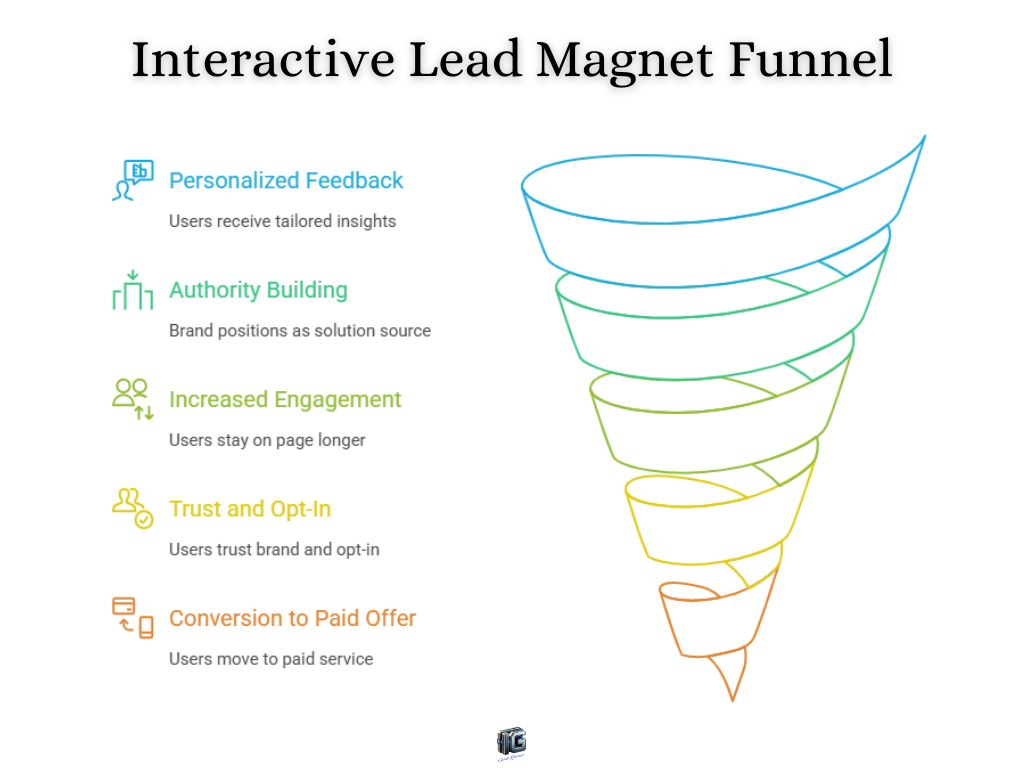
4. Resource Lists & Planners
Resource lists and planners work because they save people time and time is value. Instead of researching or organizing on their own, users get curated, ready-to-use material that helps them take immediate action.
They’re simple to create, easy to update, and consistently deliver strong opt-in rates. These formats are especially effective for creators, consultants, and educators who want to offer practical value fast.
Examples:
- 100 Free Stock Photo Sites. A curated list of copyright-safe image sources for creators, bloggers, and designers. Saves hours of searching and avoids legal issues.
- 90-Day Marketing Planner (Google Sheets or PDF). A structured content and campaign planner that helps small businesses stay consistent.
- SEO Content Calendar Template. Pre-built publishing framework for keywords, topics, and post schedules. Ideal for marketers, agencies, and SaaS blogs.
Why It Works:
- Delivers immediate utility, no long explanations required.
- Feels comprehensive and trustworthy because it’s curated for quality.
- Easy to consume, which means higher completion and satisfaction rates.
- Naturally positions you as the expert who knows where to find the best resources.
Pro Tip: Pair your resource list with a short tutorial or explainer video showing how to apply it. For example, “How to use this 90-day planner for your next content campaign.” This turns a simple list into a guided experience raising both engagement and perceived value.
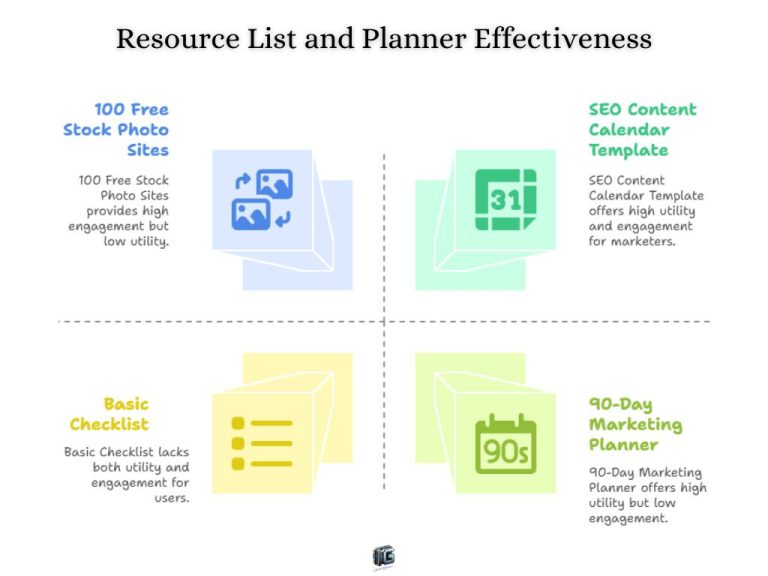
5. Guides, Workbooks & Printables
Guides and workbooks go beyond giving information; they help people apply it. They teach, prompt reflection, and often move the reader toward a specific result. These are perfect for creators who want to establish authority while delivering tangible progress.
They also tend to attract more serious leads, the ones ready to take action, not just collect freebies.
Examples:
- Career Change Workbook. A guided set of exercises to help professionals plan their next move. Popular with coaches and HR consultants who focus on career growth.
- The Ultimate Guide to LinkedIn Lead Generation. A step-by-step playbook showing real-world tactics for finding and converting leads. Ideal for B2B marketers and consultants.
- Weekly Marketing Execution Planner (Printable PDF). A simple, reusable framework for staying consistent with marketing tasks. Great for solopreneurs and small business owners.
Why It Works:
- Moves users from learning to doing, which builds trust.
- Creates perceived depth and expertise especially when it solves one focused problem.
- Easy to repurpose across formats (ebook, printable, or Notion template).
- Builds natural momentum toward paid products or coaching offers.
Pro Tip: Add a quick-win section or mini-assessment at the start. It gives readers an immediate sense of accomplishment and motivates them to finish the rest increasing both engagement and conversions.
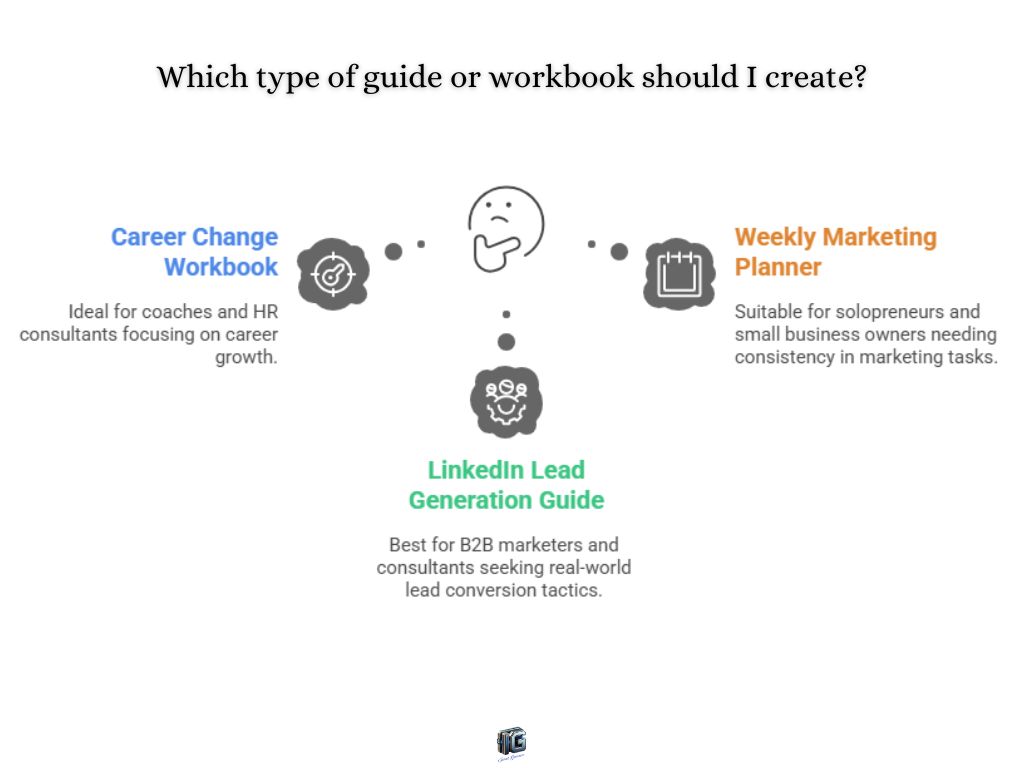
6. Educational Videos & Email Courses
Educational videos and short email courses work because they build familiarity over time. Instead of one download and done, they keep your audience engaged for days strengthening trust and positioning you as the go-to expert in your space.
They’re especially effective for audiences who prefer to see or experience the process rather than read about it.
Examples:
- Step-by-Step Video: Build a Shopify Store in 1 Hour. A complete, real-time tutorial showing beginners how to launch quickly. Ideal for ecommerce educators or SaaS platforms.
- 5-Day Email Course: How to Write Cold Emails That Convert. A daily lesson series teaching one actionable tactic per email. Works well for consultants, B2B marketers, and freelancers.
- 30 ChatGPT Prompts for Content Creators. A short, engaging series delivered by video or email that provides instant, usable value.
Why It Works:
- Builds anticipation subscribers return daily, increasing engagement and email open rates.
- Establishes authority consistent, high-value lessons show real expertise.
- Creates natural transition points to paid offers or deeper training.
Pro Tip: End each lesson with one clear action. When people implement small wins daily, completion rates rise, and your credibility grows with every email or video.
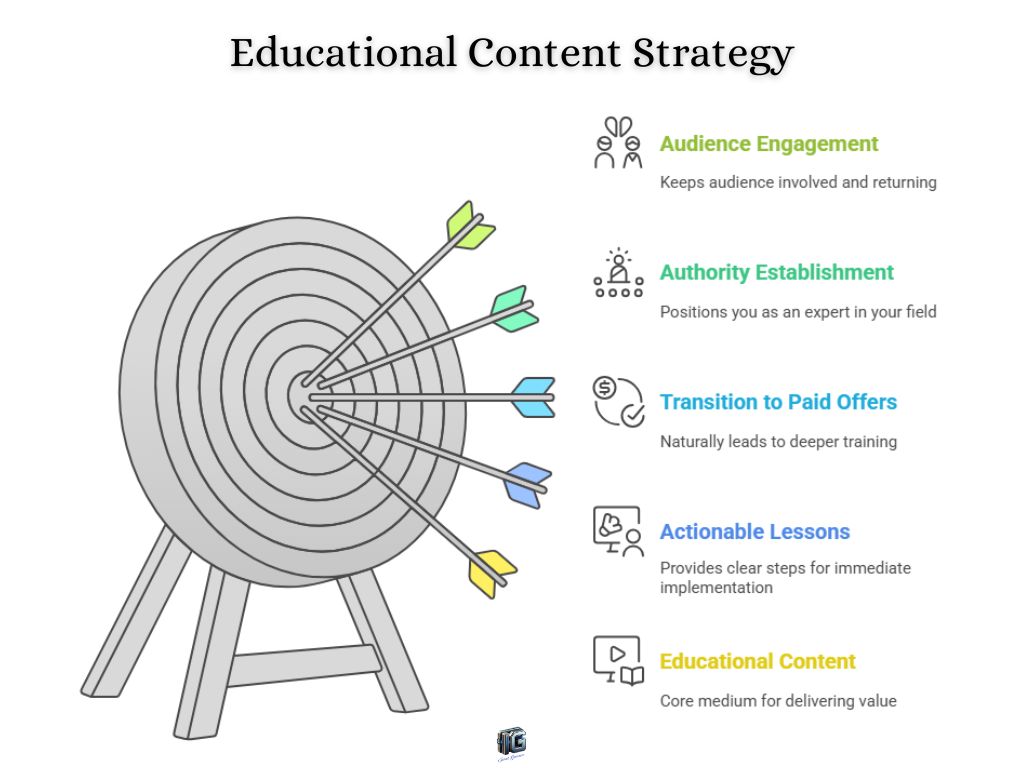
7. Webinars, Events & Community Offers
These lead magnets go beyond a download, they create direct connection. Webinars, live sessions, and private groups let prospects interact with you in real time, which builds trust faster than static content ever can.
They work best for service providers, educators, and brands that rely on authority and personal engagement to drive conversions.
Examples:
- Live Webinar: How to Scale a Service Business Without Hiring. A focused training with a short Q&A. Great for agencies, freelancers, and coaches looking to attract qualified leads.
- Virtual Summit Pass: AI Tools for Digital Marketers. Access to expert-led sessions and discussions. Perfect for SaaS brands, creators, and affiliate programs that want to grow authority fast.
- Private Slack or Discord Group for Founders & Creators. A free, curated community that builds loyalty and keeps your brand top of mind.
Why It Works:
- Real-time interaction builds credibility and connection.
- Live access feels exclusive, boosting perceived value.
- Participants who invest time in an event are far more likely to become paying customers afterward.
Pro Tip: Record your live sessions. They double as evergreen lead magnets perfect for on-demand replays, email sequences, or gated content offers.
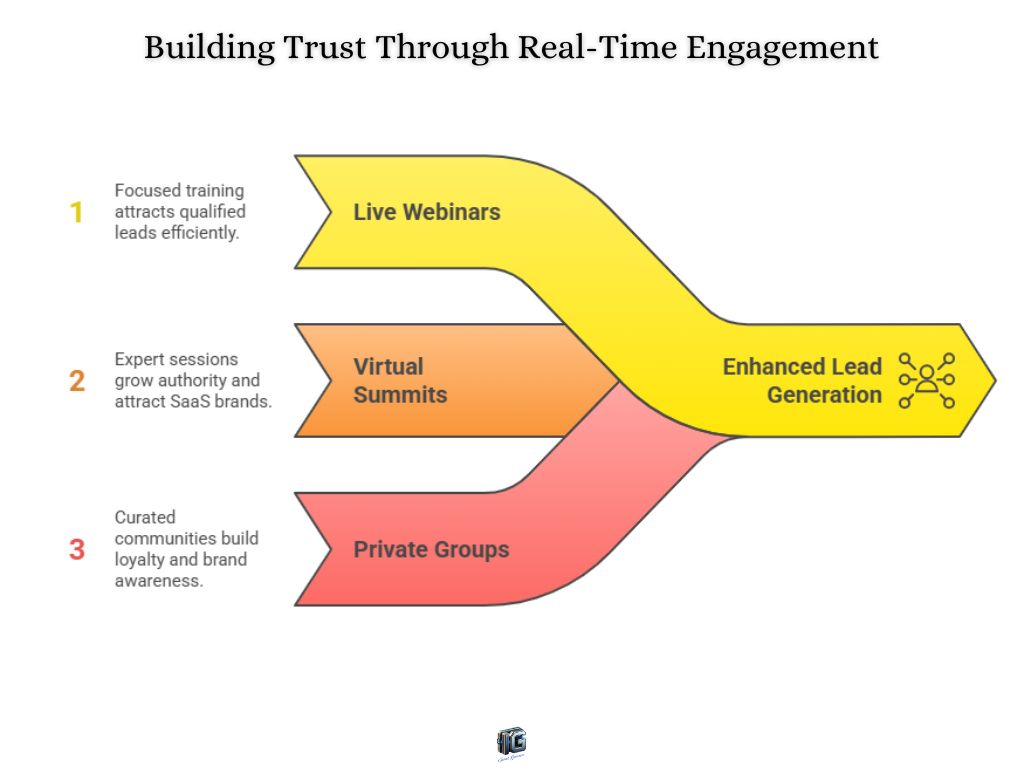
8. Special Offers & Free Trials
Sometimes the best lead magnet isn’t content, it’s access. A limited free trial, consultation, or sample of your paid product attracts prospects who are already close to buying. These offers work especially well for SaaS platforms, coaches, and service-based businesses.
Examples:
- Free 30-Minute Strategy Call. A short consultation that builds trust and positions your paid service as the logical next step.
- Free Trial of a SaaS Tool or Course Platform. Hands-on access to your core features or lessons, perfect for software companies and digital educators.
- “Just Cover Shipping” Book Offer. A low-friction, high-value entry point popular among authors, course creators, and affiliate marketers.
Why It Works:
- Converts warm leads faster by letting them experience real value upfront.
- Filters for high-intent buyers people willing to invest time are closer to purchasing.
- Reduces hesitation; the customer knows exactly what they’re getting before committing.
Pro Tip: Keep the next step clear. Pair every free offer with a follow-up email or limited-time upgrade; it’s the bridge between curiosity and conversion.
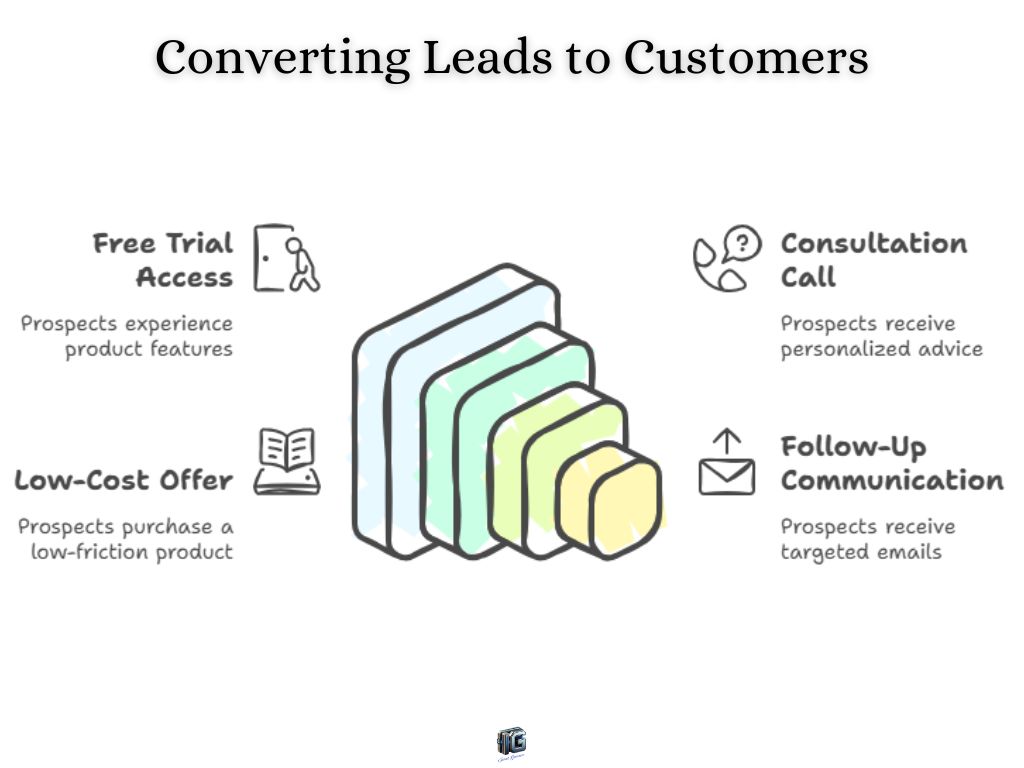
9. Gated Content & Industry Reports
Gated content works because exclusivity drives curiosity. When your resource feels premium research-based, time-sensitive, or strategy-focused people are far more willing to trade their email for access. This approach is especially effective for B2B, SaaS, and data-driven audiences.
Examples:
- 2025 Digital Marketing Trends Report. A research-backed breakdown of what’s working right now. Great for agencies, consultants, and MarTech companies building authority.
- Advanced Facebook Ads Guide (Download After Sign-Up). A detailed, tactic-heavy resource for ad managers, freelancers, and course creators.
- Cybersecurity Risk Briefing (Industry Whitepaper). An executive-level report designed to position your brand as a trusted advisor. Ideal for SaaS, IT, and compliance sectors.
Why It Works:
- High perceived value readers associate exclusive data with credibility and expertise.
- Attracts qualified leads only serious prospects download industry-level content.
- Builds long-term trust, this kind of content positions your brand as a thought leader.
Pro Tip: Keep your gated content fresh. Update data, trends, and examples at least once a year so it remains relevant and continues attracting high-quality leads.
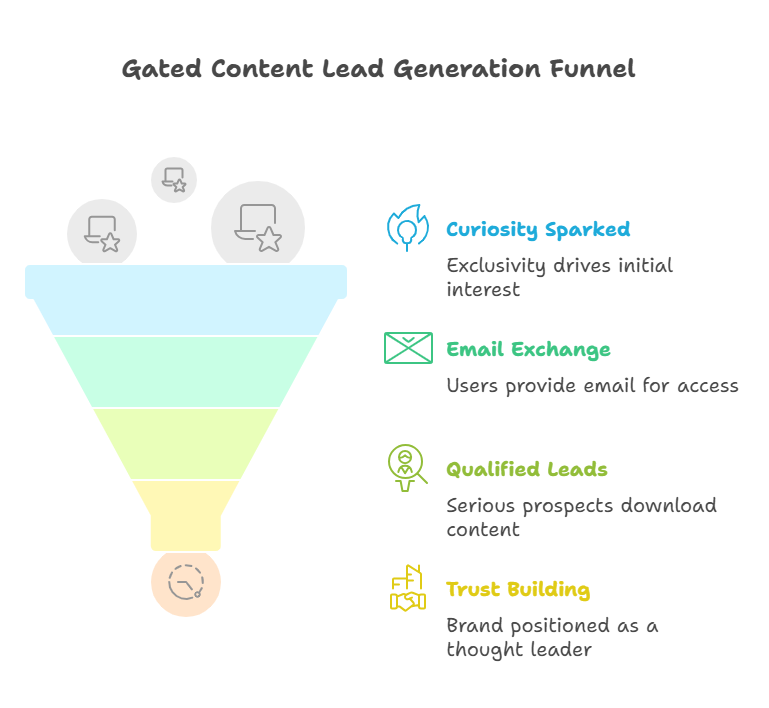
10. Quizzes, Challenges & Interactive Funnels
These lead magnets don’t just capture attention, they create engagement. By turning the experience into something interactive, you guide prospects through self-discovery while collecting valuable insights for your business.
Examples:
- Interactive Quiz: “What Type of Entrepreneur Are You?” A personality-style quiz that maps results to different buyer types. Perfect for coaches, consultants, and personal brands. Use results to segment leads for tailored follow-ups.
- 7-Day Email Challenge: Launch Your First Digital Product. A short, structured challenge that builds momentum through daily actions. Ideal for creators, educators, or affiliate marketers nurturing new audiences.
- Self-Assessment Funnel: Is Your Website Costing You Sales?. A scored diagnostic that identifies weak points and recommends next steps. Works well for agencies and SaaS products focused on optimization.
Why It Works:
- Personalization increases conversions, people engage longer when outcomes feel custom.
- Interactive experiences create micro-commitments that build trust and anticipation.
- Each response generates data you can use for smarter targeting and automation.
Pro Tip: Keep the quiz or challenge short; five questions or five days is enough. The goal is completion, not complexity.
Turn Your Content Into Ready-to-Share Lead Magnets in Minutes.
- Create instantly – Generate complete lead magnets from your videos, posts, or ideas in minutes.
- Smart assistance – AI helps structure and format your content automatically.
- Built-in opt-ins – Every lead magnet comes with its own shareable sign-up page.
- Simple dashboard – Manage and update all your lead magnets in one place.
- Effortless integration – Connect to your email tools for quick delivery and follow-up.
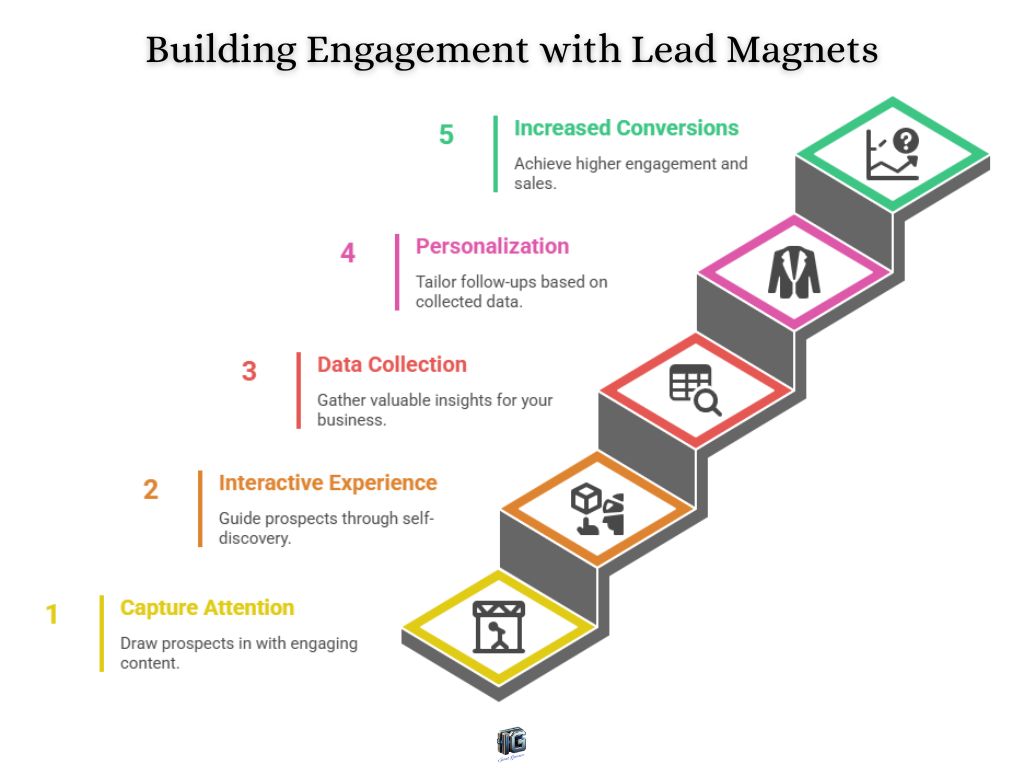
🚨 Common Mistakes When Creating Lead Magnets
Even great ideas can flop if the execution misses the mark. Most creators don’t fail because their lead magnet type is wrong, they fail because the implementation is weak. Here are the most common mistakes tied to each lead magnet format and how to fix them before you launch.
| Lead Magnet Type | Common Mistake | Why It Hurts Conversions | Quick Fix |
|---|---|---|---|
| Checklists, Swipe Files & Cheat Sheets | Too broad or generic (“Marketing Checklist for Everyone”). | Fails to connect with a clear pain point; looks like every other freebie. | Narrow it to one audience or goal. Example: “5-Step Local SEO Audit Checklist.” |
| Templates & Scripts | Overly rigid or unrealistic templates that don’t fit real-world use. | Users feel frustrated or misled when it doesn’t apply cleanly. | Offer editable versions and include quick examples or context notes. |
| Calculators & Interactive Tools | Complicated setup or unclear outcomes. | Users drop off before completing it; low perceived value. | Simplify the inputs and show instant, clear results with actionable takeaways. |
| Resource Lists & Planners | Outdated or messy curation (dead links, cluttered layout). | Looks low-quality and damages trust. | Keep resources current and categorize them clearly (e.g., “Free Tools,” “Paid Options”). |
| Guides, Workbooks & Printables | Too long or overly theoretical. | Feels like homework, not help. Leads rarely finish or act. | Focus on one transformation. Make it actionable and easy to follow. |
| Educational Videos & Email Courses | Information overload or poor pacing. | Users lose interest midway; engagement drops. | Break lessons into short, outcome-based modules. Include quick wins early. |
| Webinars, Events & Communities | No clear value or next step after sign-up. | People join but don’t engage or convert. | Set expectations upfront and close with a clear CTA (offer, replay, or next event). |
| Special Offers & Free Trials | Weak follow-up or unclear limits. | Leads sign up but don’t convert or feel misled. | Add onboarding emails and reinforce the value of upgrading early. |
| Reports & Gated Content | Overpromising “exclusive data” that’s recycled or vague. | Breaks trust and kills authority fast. | Use genuine data or insights and clearly state what makes it new or useful. |
| Quizzes & Challenges | Poor result mapping or lack of follow-up personalization. | People finish but don’t see next steps; conversions die there. | Segment results properly and send tailored follow-up content or offers. |
Bottom line: The problem usually isn’t what you’re offering, it’s how you deliver it. A great lead magnet does three things well: it solves one real problem, does it fast, and points clearly to the next logical step in your funnel. Nail those, and every format can work.

Turn Your Content Into Ready-to-Share Lead Magnets in Minutes.
- Create instantly – Generate complete lead magnets from your videos, posts, or ideas in minutes.
- Smart assistance – AI helps structure and format your content automatically.
- Built-in opt-ins – Every lead magnet comes with its own shareable sign-up page.
- Simple dashboard – Manage and update all your lead magnets in one place.
- Effortless integration – Connect to your email tools for quick delivery and follow-up.
Conclusion
A great lead magnet isn’t about creativity it’s about clarity.
Every format that converts well does one thing exceptionally: it gives your audience something they immediately value. Whether that’s a checklist, quiz, or workbook, what matters most is the outcome it delivers, not the effort behind it.
If your lead magnet solves a real problem fast, people will trade their email for it and trust you with the next step.
The examples in this guide aren’t just templates; they’re frameworks for connection. Start with one, tailor it to your audience, and focus on making it actionable.
Because when your offer earns attention, everything else gets easier: traffic converts, relationships grow, and your pipeline fills naturally.
Now pick one format. Build it. Test it. And launch it. Your next best customer is waiting for the right reason to say yes.
Next: Read our beginner-friendly Lead Magnets Guide.

Frequently Asked Questions (FAQs)
What is the most effective type of lead magnet?
An effective lead magnet solves a real problem quickly. It’s specific, easy to consume, and tied directly to your offer. The best ones deliver a clear result in minutes, not hours.
How long should a lead magnet be?
As short as possible but long enough to deliver value. A two-page checklist that gets results will always outperform a 20-page guide that doesn’t.
Can I use the same lead magnet for different audiences?
You can, but results improve when you tailor it. Adjust the headline, visuals, and examples to match each segment’s goals or pain points.
Should lead magnets always be free?
Yes, especially at the top of your funnel. Its job is to build trust and start a relationship, not to generate revenue directly.
How do I know if my lead magnet is working?
Track your opt-in rate and engagement. A solid lead magnet should convert 20–30% of visitors on a targeted landing page. Low conversions usually mean your offer or messaging needs refinement.
Where should I promote my lead magnet?
Use high-visibility spots: your homepage, blog posts, social bios, and email signature. For faster testing, run ads or pair it with guest content or collaborations.
What tools can I use to create lead magnets?
- Design: Canva, Adobe Express, or Figma
- Landing Pages: Systeme.io, Unbounce, or Leadpages
- Email Delivery: ConvertKit, Brevo, or Mailchimp
- Interactive Tools: Typeform, Outgrow, or ScoreApp
Choose tools that simplify production, not ones that add complexity.
Can I have more than one lead magnet?
Yes and you should. Different lead magnets target different stages of your funnel. Use one for cold leads, another for nurturing, and a third for conversion.
What type of lead magnet converts best in 2025?
In 2025, interactive and personalized lead magnets like quizzes, calculators, and challenges tend to convert the highest. They provide instant value while helping you segment leads for smarter follow-up.
How often should I update my lead magnets?
Review and refresh them at least once or twice a year. Update visuals, examples, and data to stay relevant. Outdated content can reduce trust and hurt conversion rates especially in fast-moving industries like marketing, tech, or finance.

2 Comments
Lead Magnets 101: What They Are & How to Use Them - Ismel Guerrero. · March 30, 2025 at 9:54 am
[…] Next Step: Want help choosing a high-converting lead magnet idea?Check out our guide on Lead Magnet Ideas for Every Niche and start building your list with […]
Lead Magnet Ideas Your Audience Can’t Ignore - Ismel Guerrero. · May 19, 2025 at 8:45 pm
[…] proven lead magnet examples working across industries and formats to see how these ideas translate into real-world […]